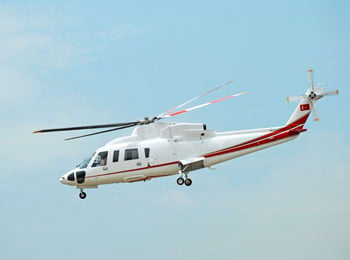Welcome back, 'copters
There's good news for the occasional patient who requires a quick transfer to or from Monmouth Medical Center: On the grounds of Long Branch Middle and High Schools, located down the street from the hospital, the helicopters are back.

There’s good news for the occasional patient who requires a quick transfer to or from Monmouth Medical Center: On the grounds of Long Branch Middle and High Schools, located down the street from the hospital, the helicopters are back.
For five years, as the campus underwent extensive renovations, the playing field that had been used as a landing zone for helicopters bringing patients in and out of the hospital was closed. The only other suitable landing site was at Allaire Airport, nearly 15 miles away.
“It was a real inconvenience to the ambulance squads, the patients and the hospital,” says Bill Arnold, Monmouth’s chief operating officer. “It took 20 to 25 minutes to get to and from the airport. We really needed a local spot.”
That spot returned this fall. The Long Branch School District once again is allowing its land to be used as a helipad. “School superintendent Joe Ferranti, the town council and our hospital officials all worked together to help to make the location work,” Arnold says.
“We thought the new soccer field at the high school would be perfect,” says Mike Perdoni, Monmouth’s administrative director of support services. “It has a fence all around it to keep bystanders away and out of danger. There are no tall impediments such as trees, light towers or electrical lines to block the pilots’ sight lines. The town, the school officials and MONOC, the ambulance service that owns the choppers, all looked at the site and agreed it would work.” Only small modifications, such as installing a larger, locked gate to allow ambulances onto and off of the field, were needed to satisfy state regulations for a helipad.
Monmouth is not a trauma center, so the pad will rarely be used for immediate emergencies such as car accidents. But should an emergency takeoff or landing be needed, the school, hospital and MONOC have carefully planned how the various parties will communicate. “When we do a landing, our procedures are to notify the school to get the field cleared in time, the police and fire departments to deploy units to the site and the hospital’s internal departments to get them ready to receive patients,” Perdoni says.
The helicopter is most often used to transfer patients to Monmouth from other regional hospitals, or from Monmouth to other facilities. For example, patients sometimes are flown to Newark Beth Israel Medical Center—like Monmouth, an affiliate of the Saint Barnabas Health Care System—for certain cardiac procedures. “On average, we do two helicopter transports a month, and most of our transports can be planned ahead of time, so we often have several hours to get things ready,” says Arnold. In fact, most flights will be scheduled for the evening, after school lets out, he says.
Arnold is grateful to the school and the town for returning the helipad to its former location. “It’s as close as you can be to the hospital without actually being on the premises,” he says.
To find out more information about services available at Monmouth Medical Center, call 1-888-724-7123

